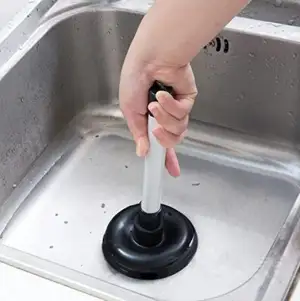Applying Plunger and Drain Cleaners: Pro Advice
Applying Plunger and Drain Cleaners: Pro Advice
Blog Article
Are you trying to locate answers about A Guide to Plungers (and How to Use Them)?

Intro
Correct maintenance of home drains pipes is necessary for avoiding clogs and making sure smooth water flow. One of the secret tools in every homeowner's toolkit is the bettor, along with numerous drainpipe cleaners created to take on stubborn blockages effectively. This short article discovers how to make use of bettors and drainpipe cleansers properly to maintain your drains pipes moving openly.
Area 1: Comprehending Plungers
Kinds of Plungers
There are several types of bettors offered, each created for different types of drains pipes and blocks. The most usual types include mug plungers, flange bettors, and accordion bettors.
How Plungers Job
Plungers work on the concept of creating stress and suction to dislodge obstructions. When appropriately applied over a drainpipe, they develop a vacuum that can take out debris or separate blockages.
Choosing the Right Bettor
Picking the appropriate bettor relies on the type of drainpipe and the nature of the obstruction. Mug plungers are perfect for sinks and tubs, while flange bettors are better matched for bathrooms due to their design.
Usual Blunders with Plungers
Staying clear of these blunders makes certain reliable plunging: inappropriate seal around the drainpipe, insufficient force, and unclear surrounding particles.
Section 2: Using Plungers Properly
Preparation
Before plunging, ensure the bettor covers the drainpipe totally and develops a limited seal. Clear any visible particles around the drain opening.
Technique
Beginning with mild plunging activities to develop suction. Increase stress slowly, using a steady rhythm. Repeat as needed until the drainpipe removes.
Repairing Tips
If plunging does not work, attempt adjusting the seal, using petroleum jelly for a far better seal, or using a various sort of plunger.
Area 3: Understanding Drain Cleaning Company
Types of Drainpipe Cleaners
Drain cleaners can be chemical or enzymatic. Chemical cleaners use solid chemicals to dissolve obstructions, while chemical cleansers make use of all-natural enzymes to break down organic matter.
Exactly How Drainpipe Cleaners Work
Chemical cleaners react with clogs to dissolve them, while enzymatic cleaners break down organic products like hair and oil without harming pipelines.
Safety and security Factors to consider
Always put on gloves and eye protection when using chemical drain cleansers. Guarantee appropriate ventilation and follow producer instructions thoroughly.
Eco-Friendly Alternatives
Consider using vinegar and cooking soda or enzyme-based cleansers for green choices that are safer for pipelines and the environment.
Area 4: Utilizing Drainpipe Cleaners Properly
Application Methods
Put chemical cleaners straight right into the drain opening. Enable them to benefit the suggested time prior to purging with hot water. Chemical cleansers should sit over night.
Precautions
Avoid mixing various sorts of cleansers, as this can produce hazardous fumes. Never ever utilize chemical cleansers combined with a bettor, as spilling can happen.
Managing Persistent Blockages
For consistent blockages, consider making use of a plumbing snake or calling a specialist plumbing professional to avoid damages to pipes.
Final thought
In conclusion, comprehending exactly how to make use of plungers and drain cleansers properly is essential for keeping healthy and balanced pipes systems. By choosing the right tools and methods, house owners can tackle small obstructions and avoid significant plumbing problems down the line.
How To Properly Use A Plumbing Snake To Clear Drains
When any drain clogs in our home arise, we tend to gravitate toward the plunger and little else. In cases where the plunger and its vacuum-created pressure are not able to clear clogs, many immediately move to harmful chemicals or simply call their plumber to fix the issue.
we’re happy to help with all drain cleaning needs and concerns. This includes informing you on a few other home remedies you may have at your disposal for minor to moderate clogs, one of which is the use of a plumbing snake. Many people have never used one of these before – let’s go over the steps to take when your drain clogs and you have a plumbing snake available.
Attempt Plunger Use
The first step here, as we noted above, should indeed be to grab your plunger when you notice a drain clog and attempt to resolve it this way. If you’re unsure how to use a particular type of plunger, our plumbers can answer any questions you have. If this doesn’t do the trick, however, you move on to the snake.
Locate And Prepare Snake
A plumbing snake is a metal or plastic device that’s generally about a quarter of an inch thick. It’s design with significant extensions, meant to reach down into your clogged drain and push the clog out. Snakes also contain drain augers that will latch onto and push stubborn blockages.
If your plunger doesn’t clear a clog, locate your snake and bring it to the drain in question. We also recommend keeping a bucket nearby to collect the clog once you pull it out, plus we’d advise wearing goggles and possibly protective gloves.
Feed Snake
Once you’re ready to go, feed the snake slowly down the drain, using the crank device it comes with to keep it moving until it finds the clog. Once this happens, much of the clog will be latched onto the coil so you can pull it out, while the rest will simply break up and flow downward.
Detach Debris
Remove the snake slowly from the drain, and once you’ve done so, pick off any debris that’s stuck to the coil. This is another area where wearing gloves is a must.
Flush Drain
Finally, take a few minutes to ensure the snake has done its job correctly. If you’ve been using it on a toilet, flush the toilet a couple times and make sure everything flows well. If you’ve used it on a different drain, flush it with some room temperature water.
https://www.mybuddytheplumber.com/blog/how-to-properly-use-a-plumbing-snake-to-clear-drains/

Application Methods
Put chemical cleaners straight right into the drain opening. Enable them to benefit the suggested time prior to purging with hot water. Chemical cleansers should sit over night.
Precautions
Avoid mixing various sorts of cleansers, as this can produce hazardous fumes. Never ever utilize chemical cleansers combined with a bettor, as spilling can happen.
Managing Persistent Blockages
For consistent blockages, consider making use of a plumbing snake or calling a specialist plumbing professional to avoid damages to pipes.
Final thought
In conclusion, comprehending exactly how to make use of plungers and drain cleansers properly is essential for keeping healthy and balanced pipes systems. By choosing the right tools and methods, house owners can tackle small obstructions and avoid significant plumbing problems down the line.
How To Properly Use A Plumbing Snake To Clear Drains
When any drain clogs in our home arise, we tend to gravitate toward the plunger and little else. In cases where the plunger and its vacuum-created pressure are not able to clear clogs, many immediately move to harmful chemicals or simply call their plumber to fix the issue.
we’re happy to help with all drain cleaning needs and concerns. This includes informing you on a few other home remedies you may have at your disposal for minor to moderate clogs, one of which is the use of a plumbing snake. Many people have never used one of these before – let’s go over the steps to take when your drain clogs and you have a plumbing snake available.
Attempt Plunger Use
The first step here, as we noted above, should indeed be to grab your plunger when you notice a drain clog and attempt to resolve it this way. If you’re unsure how to use a particular type of plunger, our plumbers can answer any questions you have. If this doesn’t do the trick, however, you move on to the snake.
Locate And Prepare Snake
A plumbing snake is a metal or plastic device that’s generally about a quarter of an inch thick. It’s design with significant extensions, meant to reach down into your clogged drain and push the clog out. Snakes also contain drain augers that will latch onto and push stubborn blockages.
If your plunger doesn’t clear a clog, locate your snake and bring it to the drain in question. We also recommend keeping a bucket nearby to collect the clog once you pull it out, plus we’d advise wearing goggles and possibly protective gloves.
Feed Snake
Once you’re ready to go, feed the snake slowly down the drain, using the crank device it comes with to keep it moving until it finds the clog. Once this happens, much of the clog will be latched onto the coil so you can pull it out, while the rest will simply break up and flow downward.
Detach Debris
Remove the snake slowly from the drain, and once you’ve done so, pick off any debris that’s stuck to the coil. This is another area where wearing gloves is a must.
Flush Drain
Finally, take a few minutes to ensure the snake has done its job correctly. If you’ve been using it on a toilet, flush the toilet a couple times and make sure everything flows well. If you’ve used it on a different drain, flush it with some room temperature water.
https://www.mybuddytheplumber.com/blog/how-to-properly-use-a-plumbing-snake-to-clear-drains/

As a fervent person who reads on Tips on How to Effectively Use a Plunger, I imagined sharing that piece of content was important. Sharing is good. Who knows, you may very well be doing someone a favor. We recognize the value of your readership.
Call Today Report this page